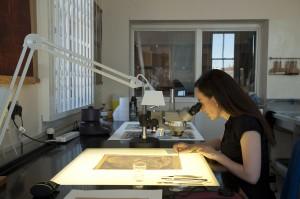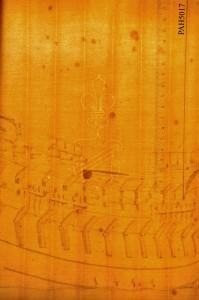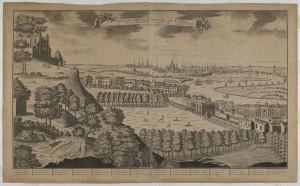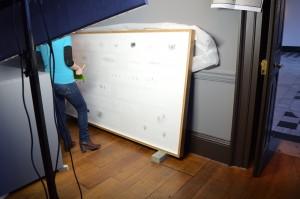23 Mar 2015
For Museum Week Clara de la Pena McTigue, Senior Prints and Drawings Conservator, talks about the work she did to prepare for our Unseen: Lives of Looking exhibition.
Hello from the Conservation team! For the past year and a half the Conservation Department has been working very closely with curator Katy Barrett and artist Dryden Goodwin, treating and mounting objects for display. The conservation team has around 25 highly trained specialists in all kinds of objects and materials such as globes, ship models or telescopes, all part of the National Maritime Museum's collection. The first job of a conservator is to examine items very closely and find ways to display them safely and spot potential damages.
With the help of the photography team, we could record the very fine craquelure on the paint layer of the Mars Globe on display. This is the lower area of the globe, which you cannot see in the case because it is attached to the stand. We often look at items under a microscope to make sure the paint layers are stable.

Conservators often examine and treat paper with the help of a light table. Looking at the structure of paper under transmitted light allows us to study their watermarks, a kind of signature used by papermakers that often helps us date drawings.

As a paper conservator, I have found it so inspiring and satisfying to work with Dryden Goodwin. He is an artist who is thoughtful about the materials he uses and how these materials will stand the test of time. The paper conservators at the museum worked together with Sam Brown, freelance mounter and framer, and offered our advice on quality papers to draw on, what framing materials will best protect the drawings inside the frames and on how to mount the drawings with "invisible hinges" to give a floating effect, using Japanese adhesives and materials which can be removed without causing any harm to the drawings. Sam was in charge not only of making the beautiful frames that contain the drawings in the exhibition, but he also worked relentlessly and impeccably at mounting around 250 drawings in his studio.


Although today museums as well as thoughtful artists such as Dryden, use conservation materials to mount and frame drawings, it has not always been this way. Objects come to us from generations past with cellotape reapairs or with damaging backings. Some of the items now on display, such as the van de Velde drawings had to be treated for tapes and hinges which were causing distortions to the drawing and the support to yellow.


The above print of Greenwich Park, also on display, had a mid twentieth century acidic backing which was causing the drawing to tear and yellow at the edges. It took us 40 hours to remove the backing with a scalpel! It is a joy to see the drawing now free from the constraining backing. It now it lies comfortably and can expand naturally in its newly conserved frame, which Tom Barrow treated for the show. The conservator's job does not end once the items are treated and mounted for display. During the installation we made sure that Dryden Goodwin's artworks were examined and documented so that we can monitor any changes that might occur during the length of the show. Once the drawings were mounted on the wall, our preventive conservator Liesa Brierley checked the light levels were adequate, to avoid damages that could be caused by light, which is one of the main causes of deterioration in paper and textiles.





